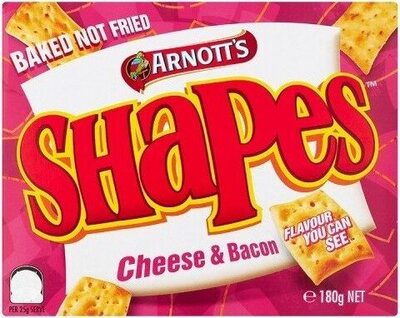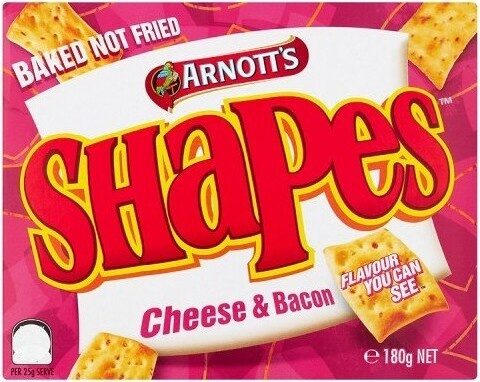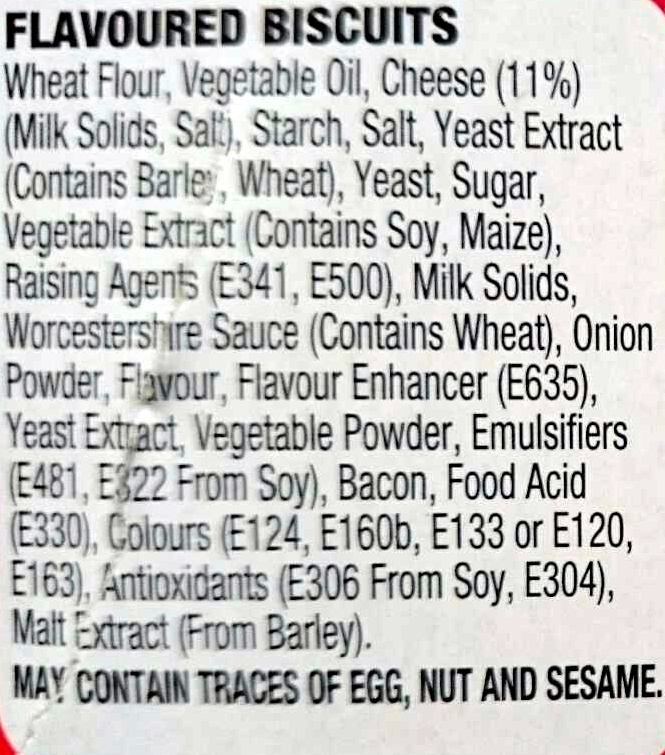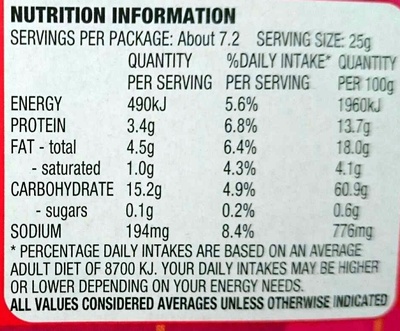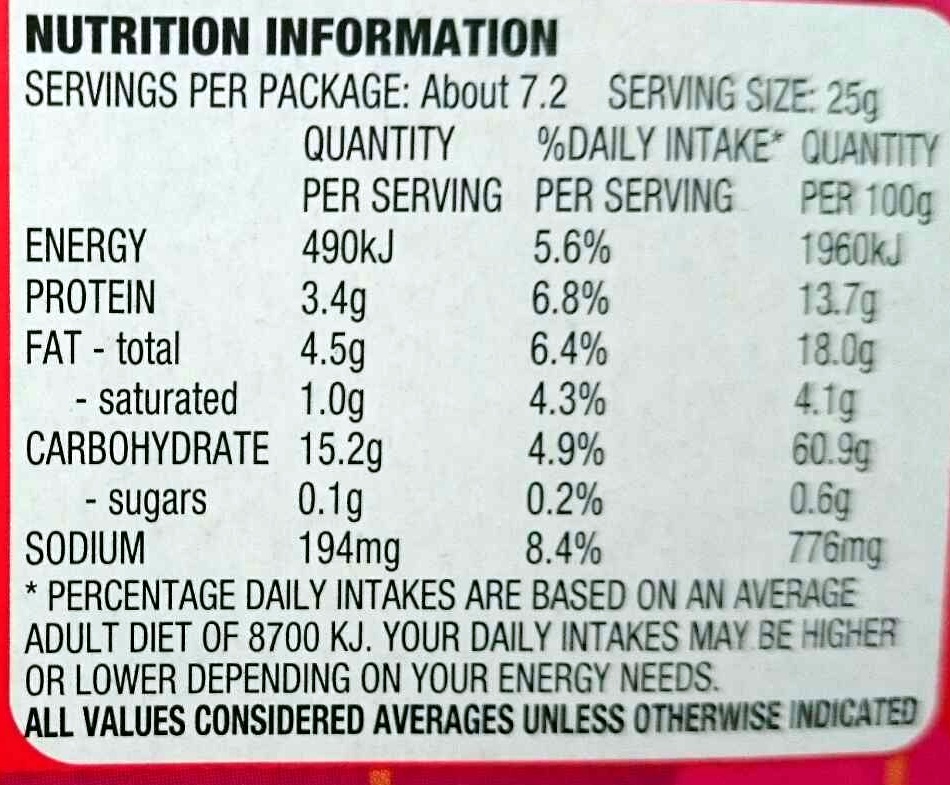Help us make food transparency the norm!
As a non-profit organization, we depend on your donations to continue informing consumers around the world about what they eat.
The food revolution starts with you!
Shapes Cheese & Bacon - Arnotts - 180 g
Shapes Cheese & Bacon - Arnotts - 180 g
This product page is not complete. You can help to complete it by editing it and adding more data from the photos we have, or by taking more photos using the app for Android or iPhone/iPad. Thank you!
×
Barcode: 9310072026275 (EAN / EAN-13)
Quantity: 180 g
Packaging: Box
Categories: Snacks, Salty snacks, Sweet snacks, Appetizers, Biscuits and cakes, Biscuits, Crackers
Labels, certifications, awards:
Australian made, Health Star Rating, Health Star Rating 2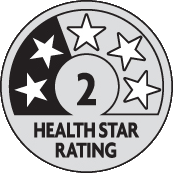
Origin of ingredients: Australia
Manufacturing or processing places: Australia
Stores: Coles, Woolworths, IGA
Countries where sold: Australia
Matching with your preferences
Health
Ingredients
-
42 ingredients
FLAVOURED BISCUITS Wheat Flour, Vegetable Oil, Cheese (11%) (Milk Solids, Sali), Starch, Salt, Yeast Extract (Contains Barle, Wheat), Yeast, Sugar, Vegetable Extract (Contains Soy, Maize), Raising Agents (E341, E500), Milk Solids, Worcestershire Sauce (Contains Wheat), Onion Powder, Flavour, Flavour Enhancer (E635), Yeast Extract, Vegetable Powder, Emulsifiers (E481, E322 From Soy), Bacon, Food Acid (E330), Colours (E124, E160b, E133 or E120, E163), Antioxidants (E306 From Soy, E304), Malt Extract (From Barley). MAY CONTAIN TRACES OF EGG, NUT AND SESAME.Allergens: Gluten, Milk, SoybeansTraces: Eggs, Nuts, Sesame seeds
Food processing
-
Ultra processed foods
Elements that indicate the product is in the 4 - Ultra processed food and drink products group:
- Additive: E120 - Cochineal
- Additive: E124 - Ponceau 4r
- Additive: E133 - Brilliant blue FCF
- Additive: E160b - Annatto
- Additive: E163 - Anthocyanins
- Additive: E322 - Lecithins
- Additive: E481 - Sodium stearoyl-2-lactylate
- Additive: E635 - Disodium 5'-ribonucleotide
- Ingredient: Colour
- Ingredient: Emulsifier
- Ingredient: Flavour enhancer
- Ingredient: Flavouring
Food products are classified into 4 groups according to their degree of processing:
- Unprocessed or minimally processed foods
- Processed culinary ingredients
- Processed foods
- Ultra processed foods
The determination of the group is based on the category of the product and on the ingredients it contains.
Additives
-
E120 - Cochineal
Carminic acid: Carminic acid -C22H20O13- is a red glucosidal hydroxyanthrapurin that occurs naturally in some scale insects, such as the cochineal, Armenian cochineal, and Polish cochineal. The insects produce the acid as a deterrent to predators. An aluminum salt of carminic acid is the coloring agent in carmine. Synonyms are C.I. 75470 and C.I. Natural Red 4. The chemical structure of carminic acid consists of a core anthraquinone structure linked to a glucose sugar unit. Carminic acid was first synthesized in the laboratory by organic chemists in 1991.Source: Wikipedia
-
E124 - Ponceau 4r
Ponceau 4R: Ponceau 4R -known by more than 100 synonyms, including as C.I. 16255, Cochineal Red A, C.I. Acid Red 18, Brilliant Scarlet 3R, Brilliant Scarlet 4R, New Coccine, is a synthetic colourant that may be used as a food colouring. It is denoted by E Number E124. Its chemical name is 1--4-sulpho-1-napthylazo-- 2-napthol- 6‚8-disulphonic acid, trisodium salt. Ponceau -17th century French for "poppy-coloured"- is the generic name for a family of azo dyes. Ponceau 4R is a strawberry red azo dye which can be used in a variety of food products, and is usually synthesized from aromatic hydrocarbons; it is stable to light, heat, and acid but fades in the presence of ascorbic acid.It is used in Europe, Asia and Australia, but has not been approved by the US FDA.Source: Wikipedia
-
E133 - Brilliant blue FCF
Brilliant Blue FCF: Brilliant Blue FCF -Blue 1- is an organic compound classified as a triarylmethane dye and a blue azo dye, reflecting its chemical structure. Known under various commercial names, it is a colorant for foods and other substances. It is denoted by E number E133 and has a color index of 42090. It has the appearance of a blue powder. It is soluble in water, and the solution has a maximum absorption at about 628 nanometers.Source: Wikipedia
-
E163 - Anthocyanins
Anthocyanin: Anthocyanins -also anthocyans; from Greek: ἄνθος -anthos- "flower" and κυάνεος/κυανοῦς kyaneos/kyanous "dark blue"- are water-soluble vacuolar pigments that, depending on their pH, may appear red, purple, or blue. Food plants rich in anthocyanins include the blueberry, raspberry, black rice, and black soybean, among many others that are red, blue, purple, or black. Some of the colors of autumn leaves are derived from anthocyanins.Anthocyanins belong to a parent class of molecules called flavonoids synthesized via the phenylpropanoid pathway. They occur in all tissues of higher plants, including leaves, stems, roots, flowers, and fruits. Anthocyanins are derived from anthocyanidins by adding sugars. They are odorless and moderately astringent. Although approved to color foods and beverages in the European Union, anthocyanins are not approved for use as a food additive because they have not been verified as safe when used as food or supplement ingredients. There is no conclusive evidence anthocyanins have any effect on human biology or diseases.Source: Wikipedia
-
E304 - Fatty acid esters of ascorbic acid
Ascorbyl palmitate: Ascorbyl palmitate is an ester formed from ascorbic acid and palmitic acid creating a fat-soluble form of vitamin C. In addition to its use as a source of vitamin C, it is also used as an antioxidant food additive -E number E304-. It is approved for use as a food additive in the EU, the U.S., Canada, Australia, and New Zealand.Ascorbyl palmitate is known to be broken down -through the digestive process- into ascorbic acid and palmitic acid -a saturated fatty acid- before being absorbed into the bloodstream. Ascorbyl palmitate is also marketed as "vitamin C ester".Source: Wikipedia
-
E322 - Lecithins
Lecithins are natural compounds commonly used in the food industry as emulsifiers and stabilizers.
Extracted from sources like soybeans and eggs, lecithins consist of phospholipids that enhance the mixing of oil and water, ensuring smooth textures in various products like chocolates, dressings, and baked goods.
They do not present any known health risks.
-
E330 - Citric acid
Citric acid is a natural organic acid found in citrus fruits such as lemons, oranges, and limes.
It is widely used in the food industry as a flavor enhancer, acidulant, and preservative due to its tart and refreshing taste.
Citric acid is safe for consumption when used in moderation and is considered a generally recognized as safe (GRAS) food additive by regulatory agencies worldwide.
-
E341 - Calcium phosphates
Calcium phosphate: Calcium phosphate is a family of materials and minerals containing calcium ions -Ca2+- together with inorganic phosphate anions. Some so-called calcium phosphates contain oxide and hydroxide as well. They are white solids of nutritious value.Source: Wikipedia
-
E481 - Sodium stearoyl-2-lactylate
Sodium stearoyl lactylate: Sodium stearoyl-2-lactylate -sodium stearoyl lactylate or SSL- is a versatile, FDA approved food additive used to improve the mix tolerance and volume of processed foods. It is one type of a commercially available lactylate. SSL is non-toxic, biodegradable, and typically manufactured using biorenewable feedstocks. Because SSL is a safe and highly effective food additive, it is used in a wide variety of products ranging from baked goods and desserts to pet foods.As described by the Food Chemicals Codex 7th edition, SSL is a cream-colored powder or brittle solid. SSL is currently manufactured by the esterification of stearic acid with lactic acid and partially neutralized with either food-grade soda ash -sodium carbonate- or caustic soda -concentrated sodium hydroxide-. Commercial grade SSL is a mixture of sodium salts of stearoyl lactylic acids and minor proportions of other sodium salts of related acids. The HLB for SSL is 10-12. SSL is slightly hygroscopic, soluble in ethanol and in hot oil or fat, and dispersible in warm water. These properties are the reason that SSL is an excellent emulsifier for fat-in-water emulsions and can also function as a humectant.Source: Wikipedia
-
E500 - Sodium carbonates
Sodium carbonates (E500) are compounds commonly used in food preparation as leavening agents, helping baked goods rise by releasing carbon dioxide when they interact with acids.
Often found in baking soda, they regulate the pH of food, preventing it from becoming too acidic or too alkaline. In the culinary world, sodium carbonates can also enhance the texture and structure of foods, such as noodles, by modifying the gluten network.
Generally recognized as safe, sodium carbonates are non-toxic when consumed in typical amounts found in food.
Ingredients analysis
-
May contain palm oil
Ingredients that may contain palm oil: Vegetable oil, E481, E304
-
Non-vegan
Non-vegan ingredients: Cheese, Milk solids, Milk solids, Bacon, E120, E120Some ingredients could not be recognized.
We need your help!
You can help us recognize more ingredients and better analyze the list of ingredients for this product and others:
- Edit this product page to correct spelling mistakes in the ingredients list, and/or to remove ingredients in other languages and sentences that are not related to the ingredients.
- Add new entries, synonyms or translations to our multilingual lists of ingredients, ingredient processing methods, and labels.
If you would like to help, join the #ingredients channel on our Slack discussion space and/or learn about ingredients analysis on our wiki. Thank you!
-
Non-vegetarian
Non-vegetarian ingredients: Bacon, E120, E120Some ingredients could not be recognized.
We need your help!
You can help us recognize more ingredients and better analyze the list of ingredients for this product and others:
- Edit this product page to correct spelling mistakes in the ingredients list, and/or to remove ingredients in other languages and sentences that are not related to the ingredients.
- Add new entries, synonyms or translations to our multilingual lists of ingredients, ingredient processing methods, and labels.
If you would like to help, join the #ingredients channel on our Slack discussion space and/or learn about ingredients analysis on our wiki. Thank you!
-
Details of the analysis of the ingredients
We need your help!
Some ingredients could not be recognized.
We need your help!
You can help us recognize more ingredients and better analyze the list of ingredients for this product and others:
- Edit this product page to correct spelling mistakes in the ingredients list, and/or to remove ingredients in other languages and sentences that are not related to the ingredients.
- Add new entries, synonyms or translations to our multilingual lists of ingredients, ingredient processing methods, and labels.
If you would like to help, join the #ingredients channel on our Slack discussion space and/or learn about ingredients analysis on our wiki. Thank you!
: FLAVOURED BISCUITS Wheat Flour, Vegetable Oil, Cheese 11% (Milk Solids, Sali), Starch, Salt, Yeast Extract (Contains Barle, Wheat), Yeast, Sugar, Vegetable Extract (Maize), Raising Agents (e341, e500), Milk Solids, Worcestershire Sauce, Onion, Flavour, Flavour Enhancer (e635), Yeast Extract, Vegetable, Emulsifiers (e481, e322 From Soy), Bacon, Food Acid (e330), Colours (e124, e160b, e133, e120, e163), Antioxidants (e306 From Soy, e304), Malt Extract (From Barley)- FLAVOURED BISCUITS Wheat Flour -> en:flavoured-biscuits-wheat-flour - percent_min: 18.2 - percent_max: 78
- Vegetable Oil -> en:vegetable-oil - vegan: yes - vegetarian: yes - from_palm_oil: maybe - percent_min: 11 - percent_max: 44.5
- Cheese -> en:cheese - vegan: no - vegetarian: maybe - ciqual_proxy_food_code: 12999 - percent_min: 11 - percent: 11 - percent_max: 11
- Milk Solids -> en:milk-solids - vegan: no - vegetarian: yes - ciqual_proxy_food_code: 19051 - percent_min: 5.5 - percent_max: 11
- Sali -> en:sali - percent_min: 0 - percent_max: 5.5
- Starch -> en:starch - vegan: yes - vegetarian: yes - ciqual_proxy_food_code: 9510 - percent_min: 0 - percent_max: 11
- Salt -> en:salt - vegan: yes - vegetarian: yes - ciqual_food_code: 11058 - percent_min: 0 - percent_max: 1.9
- Yeast Extract -> en:yeast-extract - vegan: yes - vegetarian: yes - percent_min: 0 - percent_max: 1.9
- Contains Barle -> en:contains-barle - percent_min: 0 - percent_max: 1.9
- Wheat -> en:wheat - vegan: yes - vegetarian: yes - ciqual_proxy_food_code: 9410 - percent_min: 0 - percent_max: 0.95
- Yeast -> en:yeast - vegan: yes - vegetarian: yes - percent_min: 0 - percent_max: 1.9
- Sugar -> en:sugar - vegan: yes - vegetarian: yes - ciqual_proxy_food_code: 31016 - percent_min: 0 - percent_max: 0.6
- Vegetable Extract -> en:vegetable-extract - percent_min: 0 - percent_max: 0.6
- Maize -> en:corn - vegan: yes - vegetarian: yes - ciqual_food_code: 9200 - percent_min: 0 - percent_max: 0.6
- Raising Agents -> en:raising-agent - percent_min: 0 - percent_max: 0.6
- e341 -> en:e341 - vegan: yes - vegetarian: yes - percent_min: 0 - percent_max: 0.6
- e500 -> en:e500 - vegan: yes - vegetarian: yes - percent_min: 0 - percent_max: 0.3
- Milk Solids -> en:milk-solids - vegan: no - vegetarian: yes - ciqual_proxy_food_code: 19051 - percent_min: 0 - percent_max: 0.6
- Worcestershire Sauce -> en:worcestershire-sauce - vegan: maybe - vegetarian: maybe - percent_min: 0 - percent_max: 0.6
- Onion -> en:onion - vegan: yes - vegetarian: yes - ciqual_food_code: 20034 - percent_min: 0 - percent_max: 0.6
- Flavour -> en:flavouring - vegan: maybe - vegetarian: maybe - percent_min: 0 - percent_max: 0.6
- Flavour Enhancer -> en:flavour-enhancer - percent_min: 0 - percent_max: 0.6
- e635 -> en:e635 - vegan: maybe - vegetarian: maybe - percent_min: 0 - percent_max: 0.6
- Yeast Extract -> en:yeast-extract - vegan: yes - vegetarian: yes - percent_min: 0 - percent_max: 0.6
- Vegetable -> en:vegetable - vegan: yes - vegetarian: yes - percent_min: 0 - percent_max: 0.6
- Emulsifiers -> en:emulsifier - percent_min: 0 - percent_max: 0.6
- e481 -> en:e481 - vegan: maybe - vegetarian: maybe - from_palm_oil: maybe - percent_min: 0 - percent_max: 0.6
- e322 From Soy -> en:e322-from-soy - percent_min: 0 - percent_max: 0.3
- Bacon -> en:bacon - vegan: no - vegetarian: no - ciqual_food_code: 28858 - percent_min: 0 - percent_max: 0.6
- Food Acid -> en:food-acid - percent_min: 0 - percent_max: 0.6
- e330 -> en:e330 - vegan: yes - vegetarian: yes - percent_min: 0 - percent_max: 0.6
- Colours -> en:colour - percent_min: 0 - percent_max: 0.6
- e124 -> en:e120 - vegan: no - vegetarian: no - percent_min: 0 - percent_max: 0.6
- e160b -> en:e160b - vegan: yes - vegetarian: yes - percent_min: 0 - percent_max: 0.3
- e133 -> en:e133 - vegan: yes - vegetarian: yes - percent_min: 0 - percent_max: 0.2
- e120 -> en:e120 - vegan: no - vegetarian: no - percent_min: 0 - percent_max: 0.15
- e163 -> en:e163 - vegan: yes - vegetarian: yes - percent_min: 0 - percent_max: 0.12
- Antioxidants -> en:antioxidant - percent_min: 0 - percent_max: 0.6
- e306 From Soy -> en:e306-from-soy - percent_min: 0 - percent_max: 0.6
- e304 -> en:e304 - vegan: maybe - vegetarian: maybe - from_palm_oil: maybe - percent_min: 0 - percent_max: 0.3
- Malt Extract -> en:malt-extract - vegan: yes - vegetarian: yes - percent_min: 0 - percent_max: 0.6
- From Barley -> en:barley - vegan: yes - vegetarian: yes - percent_min: 0 - percent_max: 0.6
Nutrition
-
Poor nutritional quality
⚠ ️Warning: the amount of fruits, vegetables and nuts is not specified on the label, it was estimated from the list of ingredients: 0This product is not considered a beverage for the calculation of the Nutri-Score.
Positive points: 3
- Proteins: 5 / 5 (value: 13.7, rounded value: 13.7)
- Fiber: 3 / 5 (value: 3.2, rounded value: 3.2)
- Fruits, vegetables, nuts, and colza/walnut/olive oils: 0 / 5 (value: 0, rounded value: 0)
Negative points: 17
- Energy: 5 / 10 (value: 1958, rounded value: 1958)
- Sugars: 0 / 10 (value: 0.6, rounded value: 0.6)
- Saturated fat: 4 / 10 (value: 4.1, rounded value: 4.1)
- Sodium: 8 / 10 (value: 760, rounded value: 760)
The points for proteins are not counted because the negative points are greater or equal to 11.
Nutritional score: (17 - 3)
Nutri-Score:
-
Nutrient levels
-
Fat in moderate quantity (18%)
What you need to know- A high consumption of fat, especially saturated fats, can raise cholesterol, which increases the risk of heart diseases.
Recommendation: Limit the consumption of fat and saturated fat- Choose products with lower fat and saturated fat content.
-
Saturated fat in moderate quantity (4.1%)
What you need to know- A high consumption of fat, especially saturated fats, can raise cholesterol, which increases the risk of heart diseases.
Recommendation: Limit the consumption of fat and saturated fat- Choose products with lower fat and saturated fat content.
-
Sugars in low quantity (0.6%)
What you need to know- A high consumption of sugar can cause weight gain and tooth decay. It also augments the risk of type 2 diabetes and cardio-vascular diseases.
Recommendation: Limit the consumption of sugar and sugary drinks- Sugary drinks (such as sodas, fruit beverages, and fruit juices and nectars) should be limited as much as possible (no more than 1 glass a day).
- Choose products with lower sugar content and reduce the consumption of products with added sugars.
-
Salt in high quantity (1.9%)
What you need to know- A high consumption of salt (or sodium) can cause raised blood pressure, which can increase the risk of heart disease and stroke.
- Many people who have high blood pressure do not know it, as there are often no symptoms.
- Most people consume too much salt (on average 9 to 12 grams per day), around twice the recommended maximum level of intake.
Recommendation: Limit the consumption of salt and salted food- Reduce the quantity of salt used when cooking, and don't salt again at the table.
- Limit the consumption of salty snacks and choose products with lower salt content.
-
-
Nutrition facts
Nutrition facts As sold
for 100 g / 100 mlCompared to: Crackers Energy 1,958 kj
(468 kcal)+8% Fat 18 g +23% Saturated fat 4.1 g +17% Carbohydrates 60.9 g -1% Sugars 0.6 g -83% Fiber 3.2 g -43% Proteins 13.7 g +41% Salt 1.9 g +39% Fruits‚ vegetables‚ nuts and rapeseed‚ walnut and olive oils (estimate from ingredients list analysis) 0 %
Environment
-
Eco-Score A - Very low environmental impact
⚠ ️The full impact of transportation to your country is currently unknown.The Eco-Score is an experimental score that summarizes the environmental impacts of food products.→ The Eco-Score was initially developped for France and it is being extended to other European countries. The Eco-Score formula is subject to change as it is regularly improved to make it more precise and better suited to each country.Life cycle analysis
-
Average impact of products of the same category: A (Score: 87/100)
Category: Salty snacks, crackers, plain
Category: Salty snacks, crackers, plain
- PEF environmental score: 0.22 (the lower the score, the lower the impact)
- including impact on climate change: 1.59 kg CO2 eq/kg of product
Stage Impact Agriculture
59.7 %Processing
22.4 %Packaging
10.6 %Transportation
5.2 %Distribution
2.2 %Consumption
0.0 %
Bonuses and maluses
-
Origins of ingredients with a high impact
Malus:
Environmental policy: +3
Transportation: 0
Origin of the product and/or its ingredients % of ingredients Impact Australia 100 %Medium
-
Packaging with a medium impact
Malus: -10
Shape Material Recycling Impact Box Unknown High ⚠ ️ The information about the packaging of this product is not sufficiently precise (exact shapes and materials of all components of the packaging).⚠ ️ For a more precise calculation of the Eco-Score, you can modify the product page and add them.
If you are the manufacturer of this product, you can send us the information with our free platform for producers.
Eco-Score for this product
-
Impact for this product: A (Score: 80/100)
Product: Shapes Cheese & Bacon - Arnotts - 180 g
Life cycle analysis score: 87
Sum of bonuses and maluses: -10
Final score: 80/100
-
Carbon footprint
-
Equal to driving 0.8 km in a petrol car
159 g CO² per 100g of product
The carbon emission figure comes from ADEME's Agribalyse database, for the category: Salty snacks, crackers, plain (Source: ADEME Agribalyse Database)
Stage Impact Agriculture
53.6 %Processing
18.8 %Packaging
17.7 %Transportation
8.7 %Distribution
1.2 %Consumption
0.0 %
Packaging
-
Packaging with a medium impact
-
Packaging parts
Box
-
Packaging materials
Material % Packaging weight Packaging weight per 100 g of product
-
Transportation
-
Origins of ingredients
Origins of ingredients with a high impact
Origin of the product and/or its ingredients % of ingredients Impact Australia 100 %Medium
Report a problem
-
Incomplete or incorrect information?
Category, labels, ingredients, allergens, nutritional information, photos etc.
If the information does not match the information on the packaging, please complete or correct it. Open Food Facts is a collaborative database, and every contribution is useful for all.
Data sources
Product added on by foodorigins
Last edit of product page on by quentinbrd.
Product page also edited by archanox, clockwerx, date-limite-app, ecoscore-impact-estimator, foodvisor, kiliweb, marilyn, openfoodfacts-contributors, packbot, roboto-app, silverorion, tacite, tbound2, yuka.ZHF3Nk5hVWNxOU00cHM4ZitFbnE4SU4rMnBTeFlteThEN3NqSVE9PQ, yuka.sY2b0xO6T85zoF3NwEKvlmB4auTT8zLBGkfkl1eG4tqvNr_EeOEq2JPiaqs, yuka.sY2b0xO6T85zoF3NwEKvlnYdf9_chh3IBz_vgEuXmvKqArnHf8x3xa3jEao, yuka.sY2b0xO6T85zoF3NwEKvlnx7VovlvBzvMhXhkhyy5vqqJZ22P_Nd5qrXMKg, yukafix.
